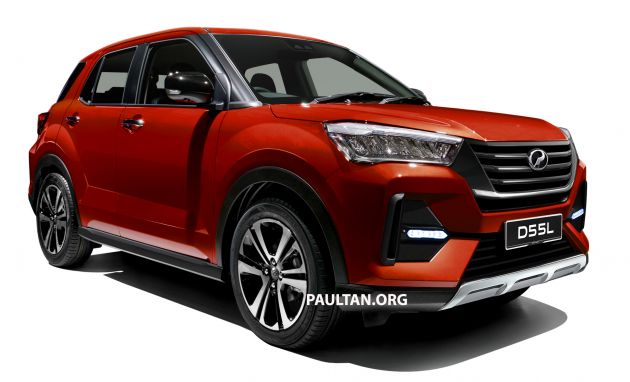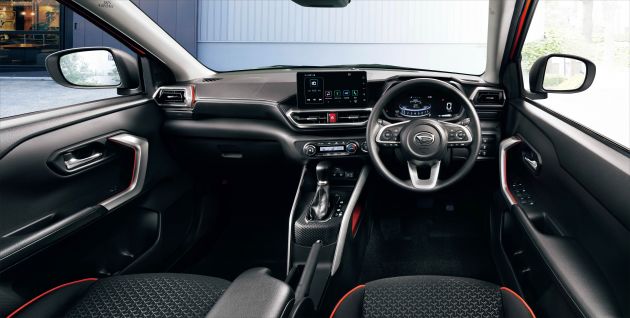2021 Perodua D55L SUV – everything we know so far
It’s no secret that Perodua has a new compact SUV on the way, which will take its place above the Myvi in the local line-up. Currently without a name and commonly referred to as the D55L, this will be the national carmaker’s next product that will look to draw in massive sales figures, given the popularity of SUVs these days.
Unfortunately, we won’t see the finished D55L in full this year, despite what was mentioned in previous reports. Perodua president and CEO Datuk Zainal Abidin Ahmad stated back in August that due to the movement control order (MCO), the launch schedule for the D55L had to be adjusted, so we’ll probably have to wait until 2021 to see what’s what.
A recent sighting of a camouflaged D55L is a good sign that the company is on track to deliver, and is bound to generate plenty of buzz in our local automotive sphere. So, to bring you up to speed, here’s what we know about the D55L so far.
Why is everyone calling it the Perodua D55L?
Well, that’s because it doesn’t have an official name yet, and it is internally known as the D55L. This alphanumeric style of naming projects has been the case with Perodua models for some time, as the Aruz was known as the D38L, the current Myvi was referred to as the D20N, the Axia as the D87A, and the Bezza as the D63D.
I keep hearing about the Daihatsu Rocky when the Perodua D55L is mentioned. What’s up with that?
During Perodua’s full year review last year, the company revealed that it plans to develop models based on the Daihatsu New Global Architecture (DNGA), which is what underpins the latest Rocky as well the rebadged Toyota Raize.
So, yes, the D55L is expected use the same platform as the Rocky, but it is likely not a straight rebadge, as was the case with Perodua’s previous SUV efforts like the Kembara and Nautica – both were based on the Terios at the time.
As we’ve seen with the Myvi, which has an upper body and interior that was fully designed by Perodua, as well as the Aruz that differs (inside and out) from the current Terios and Toyota Rush, the fruitful partnership has allowed Daihatsu to entrust the national carmaker to perform its own development work and change the design of vehicles as they see fit.
Based on recent spyshots of the D55L, we can see that the overall profile doesn’t differ much from the Rocky, but there are changes to its front and rear, as suggested by the heavy camouflage the prototype is wearing. As a result, expect the D55L to have noticeably different exterior design compared to its Daihatsu sibling, and this should extend to its interior, which should receive Malaysian touches – cue the tapau and teh tarik hooks.
When you say “compact SUV,” how small will the Perodua D55L be?
If we look at the Rocky, it measures 3,995 mm long, 1,695 mm wide and 1,620 mm tall, and has a wheelbase that spans 2,525 mm. These figures should also apply to the D55L, given its association to the Rocky, and shouldn’t differ significantly.
Compared to Perodua’s previous compact SUVs, the Rocky occupies a larger footprint compared to the Kembara, which was 3,890 mm long, 1,555 mm wide, 1715 mm tall, and with a 2,420 mm wheelbase. However, it’s dwarfed by the Nautica that was 4,115 mm long, 1,695 mm wide, 1,740 mm tall, and had a 2,580 mm wheelbase.
Ok, so what’s going to be under the bonnet?
A good question, but one that doesn’t have an outright answer for now. As the D55L will have Rocky underpinnings, it can be assumed that the engine used will be the same too. In Japan, the Rocky is offered with a sole powertrain, consisting of a 1KR-VET 1.0 litre (996 cc) turbocharged three-cylinder petrol engine that makes 98 PS (97 hp) at 6,000 rpm and 140 Nm of torque from 2,400 to 4,000 rpm.
If the engine code sounds familiar, it is essentially the turbocharged version of the 1KR-VE currently used in the Axia and Bezza. The 1KR-VET features variable valve timing, DOHC, 12 valves and an idling stop system, with a CVT being its only transmission pairing over there. Front- and all-wheel drive are available, although the former is more likely for our part of the world.
It would certainly be big news if we do get the D55L with the 1KR-VET and a CVT, as it would mark the first time a Perodua model gets turbocharging as well as a transmission that isn’t a conventional torque converter automatic.
There is some evidence that points towards this powertrain package being used, as back in December last year, two units of the Daihatsu Thor were spotted in Melaka with an attached transmission cooler. The Thor has the same setup as the Rocky, and it was assumed that Perodua is testing this package to ensure it can cope with our demanding climate.
When will the Perodua D55L be launched? How much?
Definitely not in 2020, as mentioned at the start, so expect a launch to take place some time in 2021. An exact date hasn’t been announced for now, and the pricing is also another mystery. Perodua’s current line-up is priced from RM23,367 for a base Axia 1.0 E, and goes all the way up to RM73,226 for the range-topping Aruz 1.5 AV.
Seeing how the D55L will take its place below the larger Aruz, which starts from RM68,526, a price range that is from around the RM50,000 mark is possible, although this will overlap with the Myvi range. That shouldn’t be a big concern, because if you want a hatchback, you’d go with the Myvi, and if you wanted an SUV, there’s the D55L.
Will it compete directly against the Proton X50?
On paper, no. The D55L is more of a really, really small B-segment model – it’s actually closer to being an A-segment and is known as such in Japan – given its purported dimensions, while the X50 is a properly-sized B-segment SUV. Bringing out the figures, X50 is larger than the Rocky, as it is 4,330 mm long, 1,800 mm wide, 1,609 mm tall, and has 2,600 mm wheelbase.
As such, it’s not an apples-to-apples comparison, but those in the market for a compact SUV from a local brand will likely have both models under consideration before making a purchase. It isn’t far-fetched to assume that the D55L will be priced even lower than Aruz, as we just talked about, so it should be considerably cheaper than the X50 that starts well above the entire Perodua range, from RM79,200
What equipment can we expect?
Once again, we have to look to the Rocky for a rough idea. The SUV in Japan, in its highest grade, comes with LED headlights, fog lights, daytime running lights and taillights, along with 17-inch wheels, a seven-inch TFT instrument cluster display, automatic air-conditioning, and a nine-inch touchscreen head unit. By right, it shouldn’t be worse than the Myvi, as the hatchback already has keyless entry and engine start, as well as LED headlamps across the board.
On the safety front, the Rocky has the usual passive systems like Vehicle Stability Control, traction control, ABS, EBD, brake assist, six airbags and Isofix child seat anchors. As for active safety systems, the list includes autonomous emergency braking (AEB), lane keep warning and assist, a blind spot monitor, auto high beam, adaptive headlights, adaptive cruise control, lane keep control, rear cross-traffic alert, and parking assist.
Perodua has said in the past that it intends to keep up with global trends, so Level 2 autonomous driving systems, like some mentioned above, are likely to be fitted to the D55L, at least on higher variants. Given that many of its models like the Axia, Aruz, Myvi and Bezza have Perodua’s Advanced Safety Assist (ASA) suite, which includes AEB, we reckon the D55L will also follow suit.
Anything else?
We’ve already written a few articles in the past related to the D55L, so here’s a list of them for further reading:
- SPYSHOT: Perodua D55L SUV, first sighting of Rocky!
- Perodua D55L SUV not being launched this year
- Perodua D55L SUV: DNGA confirmed, 1.0L Turbo, electrification, autonomous drive likely – launch Q4?
- SPIED: Daihatsu Thor in Malaysia with oil cooler – Perodua testing 1.0L turbo, CVT for D55L SUV?
- Perodua D55L SUV vs Proton X50 – we compare specs of Daihatsu Rocky/Toyota Raize and Geely Binyue
- Upcoming Perodua D55L model rendered based on Daihatsu’s New Compact SUV, as seen in Tokyo
- Upcoming Perodua D55L SUV set to debut DNGA platform in Malaysia – 1.0 Turbo engine could feature
- Tokyo 2019: Daihatsu previews new compact SUV – is this an early look at Perodua’s D55L B-segment SUV?
We will continuously update this post with more information as and when they become available, so keep an eye on this space to know more about the upcoming Perodua D55L.
The post 2021 Perodua D55L SUV – everything we know so far appeared first on Paul Tan's Automotive News.
from Paul Tan's Automotive News
Read The Rest:paultan...











Post a Comment